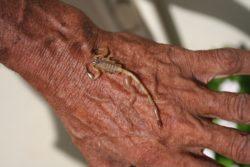Here is a list of the amazing wildlife that makes the beautiful land of St John their home.
American Kestral (Falco sparverius)
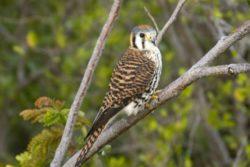

The American Kestral, also known as a sparrow hawk or killy killy is a relatively small raptor whose habitat ranges from as far north as Alaska south to the islands of the Caribbean. They grow to about 12 inches in length and feed on lizards, insects, small birds and rodents.
Bananaquit (Coereba flaveola)
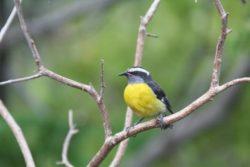
The bananaquit, also called yellow bird, bananabird and sugar bird, is a commonly seen St. John resident. They suck the nectar from flowers with their curved beaks and will also eat fruit and small insects.
The local Virgin Islands name,” sugar bird,” comes from the fact that they are easily attracted by setting out bowls of sugar.
Jamaican Red-Tailed Hawk (Buteo jamaicensis)
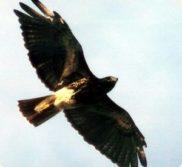
Although native to Jamaica the Jamaican Red-Tailed Hawk can be found on St. John and throughout North America.
The females tend to be larger than the males and measure between 20 and 25 inches in length with a wingspan of up to 54 inches. Males measure between 18 and 23 inches in length with a wingspan up to 45 inches. Females weigh between 2 and 3½ pounds, males between 1½ and 2½ pounds.
Red-tailed hawks are said to be capable of flying at speed of more than 60 mph. Their diet consists mostly of small mammals.
Hummingbird
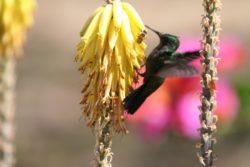
Mangrove Cuckoo (Coccyzus minor)
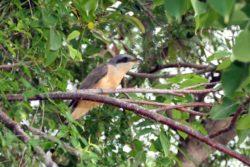
The Mangrove Cucko, can be found in mangrove swamps. They are usually quite hidden and are difficult to find. They make a gaw-gaw-gaw-gaw-gaw sound. They live on insects and make their roughly constructed nests out of twigs. The clutch consists of 2 to 3 pale green-blue eggs.
Brown Pelican
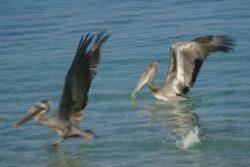
The brown pelican is one of the most common and easily recognizable birds found on St. John. Like the human population of the island some brown pelicans are native Virgin Islanders and permanent residents, while others are temporary residents who come to St. John from North America for the winter season.
The brown pelican is a large bird, weighing as much as ten pounds and having a wingspan of up to eight feet. A decent-sized pelican can consume about four pounds of fish a day.
Brown pelicans are excellent fishermen. This is extremely fortunate for them, because if they had to buy their fish at today’s prices they’d need to have good jobs and make lots of money, not an easy trick on St. John, especially for a pelican.
Although pelicans are often perceived as ungainly or clumsy when seen on land, they are extremely graceful in the air. They maneuver with ease and can reach airspeeds of over 35 mph, and with a good tailwind their ground speed can be over 60 mph.
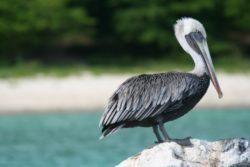
Scaly-Naped Pigeon (Columba squamosa)
At 14 – 16 inches in length and wine colored in tone, the Scaly-Necked Pigeon is much larger and darker than ordinary doves. On St. John they inhabit the wooded hillsides.
Seagull
The Great Black-backed Gull, Larus marinus, breeds on the coasts of Euope and America as wll as in the Caribbean. It’s a very large gull that takes about four to five years to mature. The call is a deep “laughing” cry. They are omnivores that scavange, hunt and often steal the catch of other seabirds.
Two species of snakes can be found on St. John, the blind snake and the garden snake; both are harmless.
Snakes

The blind snake (Ramphotyphlops braminus) lives underground. Unless you look really close, you could easily mistake it for a worm. This species can be found, not only on St. John, but also just about all over the world. They are blind, notwithstanding their two vestigial eyes. Another interesting factoid about the blind snake is that it is unisexual. No males have ever been found. Go figure
The garden snake is longer than the blind snake, about a foot long. I have only seen one once in all the time I’ve been on St. John, but it disappeared into the bush before I could focus my camera, so the above image belongs to Photo: dpnr.gov.vi
Snowy Egret
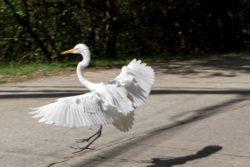
Flamingo
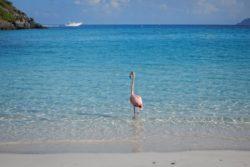
You can see flamingos on Anegada and sometimes on Virgin Gorda. The above image was photographed on Brias Creek in Virgin Gorda
Since then flamingos have been spotted on Necker Island and Tortola and the now they’re on St. John.
Parrot
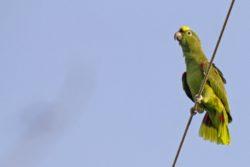
Thrushie
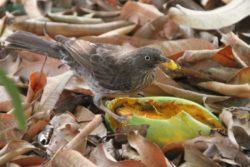
Native Tree Frogs
Each night as the sun sets an unseen orchestra begins its concert. The music can be heard all over the island, but it is particularly evident in less developed areas.
Let us introduce the musicians:
Antillean tree frog – Continuous “churee – churee”
Whistling frog – High-pitched prolonged whistle often followed by a clicking sound
Coqui – “Ko – KEY” followed by a long pause “Ko – KEY”
White Lipped Frog – “queeee – queeeee – queeee”
Coqui – “Ko – KEY” followed by a long pause “Ko – KEY”
White Lipped Frog – “queeee – queeeee – queeee”
White-Tailed Deer
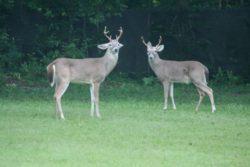
The white-tailed deer is the most common deer in North America. It is also found in southern Canada, Central America and has been introduced in parts of Europe, South Island, New Zealand, and the Virgin Islands.
The Wildlife Restoration Act of 1937 provided funding for the stocking of white-tailed deer on St. John and St. Thomas.
Sheep
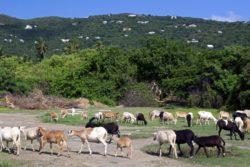
In the Virgin Islands, where the sheep don’t have fluffy wool, it’s not so easy to tell the difference between sheep and goats. Here’s the key; sheep tails go down, goat tails go up.
Donkeys (Equus asinus)
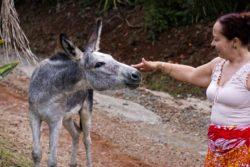
Donkeys were used in plantation era for transportation and to operate sugar mills. No longer needed by man, they remain on St. John traveling in small social groups. After fighting a long and losing battle to keep donkeys off the resort property, Caneel Bay has recently chosen to co-exist with their four-legged, non-paying guests.
Frangipani Caterpillars (Pseudosphinx tetrio)
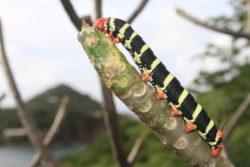
Periodically the leaves of the frangipani tree are eaten by beautiful, large, black and yellow caterpillars with red heads called frangipani caterpillars (Pseudosphinx tetrio).
After The caterpillars eat up all the leaves they begin a metamorphosis and eventually become a big dark moth called the sphinx moth.
The tree survives and grows new leaves.
Iguanas
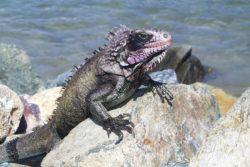
The Iguana is a type of lizard found in the Caribbean and in tropical Central and South America.
The name “iguana” comes from the Taino language. They live in trees and can grow to be as much as six feet long. They have spines on their backs and tails that they use for defense by whipping their tails. Their tails will break off if grabbed allowing the iguana to escape, whereupon it will grow a new tail.
Their dewlaps, which hang from their lower jaws are used to regulate body temperature and to attract iguanas of the opposite sex. Iguanas eat plants utilizing their sharp teeth to shred leaves and plant matter. They seem to especially love hibiscus flowers.
Hermit Crab
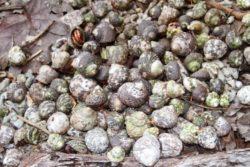
A Virgin Island riddle challenges you to identify the creature that has the following characteristics: “I live on land and walk about, but always home, in or out.”
The answer is the hermit crab, which can indeed be found just about anywhere on St. John walking about, always carrying its home along with it.
Land Crab (Cardisoma guanhumi)
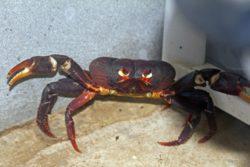
Hunting land crabs for food is a part of St. John culture and probably has been so since the first human beings came here about 3,000 years ago. The primary use of the land crab is to provide the essential ingredient for the tasty West Indian dish known simply as crab and rice.
Land crabs, called pond crabs by British Virgin Islanders and jueyes by people from Puerto Rico and Santo Domingo, are grayish-colored crabs that live in the network of holes found in low-lying areas near mangrove swamps, salt ponds, wetlands, and marshes.
They are rather large crabs, growing to about four or five inches in diameter not including their formidable claws. During the day, you may see them standing just outside a hole into which they will quickly descend as soon as they notice your approach.
An essential ingredient for the dish “crab and rice” is the crab. They cannot be bought at any store, so you first have to catch some crabs. Crab hunting is usually a group activity that takes place in the spring and summer on a waning moon, a time Virgin Islanders call dark night.
This is when the land crab is most likely to be found out of its hole. Crabs are very skittish and have excellent senses of hearing and sight, so normally it is extremely difficult to sneak up on them and catch them. If you shine a bright light on them at night, however, they tend to stop in their tracks, blinded by the glare.
Land crabs should always be purged before cooking them. The most important reason is that because they live in habitats where manchineel trees are also found, and because they are immune to the manchineel poison, they may have yet undigested manchineel leaves in their system. Purging also improves the crab’s flavor as it rids the crab of anything disgusting it may have eaten.
To purge the crab, you must put it in a cage with plenty of ventilation and access to food and water. Feed the crabs such things as cornmeal, table scraps, coconut meat, and crab bush. Keep the cage clean, and periodically wet the crabs with water.
Mongoose
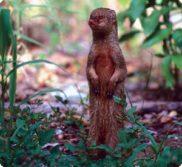
The mongoose looks like a stretched-out squirrel that is often seen speeding about the island. The history of the mongoose in St. John demonstrates the usual result of man’s interference in the natural order of things.
The mongoose was brought here from India to control the rat population. Unfortunately, the rats in the Virgin Islands are nocturnal and live in trees during the day. They were, therefore able to eat as much sugar as they wanted by night while the mongoose was sleeping and was safe, during the day, from the mongoose, which cannot climb trees.
The mongoose did have a great impact on other species, though. Mongooses sought out chickens, ground-nesting birds and their eggs, as well as turtle, lizard, and iguana eggs. The rats meanwhile were free to eat the planter’s sugar and the eggs of tree-nesting birds.
The mongoose became a nuisance for farmers and an environmental problem. This was officially recognized at least as early as 1936. In that year, there was only one sign posted in all of St. John. It was nailed to the palm tree nearest the town dock in Cruz Bay. It was signed by the Government Secretary and embossed with the government seal. It announced a bounty, dead or alive, for mongooses. Fifteen cents for a male and twenty-five cents for a female.
There is an old Virgin Island saying:
Mongoose say: “If I had a cent, I would leave this island”
Chicken say: “If I had a cent, I would lend it to you.”
Pigs

Many of the domestic pigs, originally brought to St. John by the first European colonists, have escaped into the bush and reverted back to their wild state.
Aphids
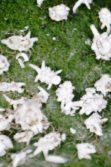
Dragonfly
Dragonflies can usually be seen around St. John’s fresh water pools, such as can be found at the Petroglyphs or along the Fish Bay Guts.
Jack Spaniards
Jack Spaniard wasps build their nests on thin branches, unfortunately usually at face level. They are not particularly aggressive, but if you disturb their nests they will sting you, sometimes more than once and they sting hard. So if your walking in the bush, be on the lookout.
I was told by a native Virgin Islander, and I witnessed the same, that if you take their nest they will not bother you. He carefully broke off the branch and threw it to the ground. The wasps swarmed around the nest, but didn’t come after us.
A Puerto Rican friend of mine will clap his hands over the nest squashing all the wasps and not get stung. My advise though is, “don’t try this at home, kids.”
Some people seem to react to the venom especially if you continue working or exerting themselves immediately after the sting so if you do get stung it’s probably a good idea to take it easy for a while.
Golden Orb Spider (Nephila clavipes)
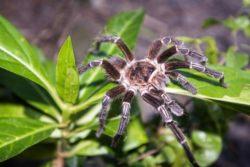
The golden orb spider is one of the many spiders in the orb weaver family. The orb weaver makes webs sometimes reaching from 15-20 feet. The golden orb is the only spider known to make its webs strong enough to be used for various kinds of bags and fishnets. Although this spider does not sting, the females are known to eat their mates after sex.
Termites
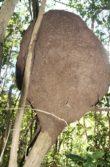
The scientific name of these creatures is Nasutitermes. On St. John they are commonly called wood lice or wood ants or simply termites. Our Latin friends call them comejen and down island they’re known as pul bois. Another species, called subterranean termites, also inhabits St. John, but their nests are built underground, and you usually don’t see them until they start eating up things in your house.
In late summer the reproductive castes of St. John termites begin their preparation to leave their nest for the first and only time in their lives. They develop wings to fly with and compound eyes to give them the temporary sense of sight, which they will need in the vast and perilous world outside the confines of the termitarium. They also change from their usual pale color to a dark brown, the newly acquired pigment being necessary to protect them from the light of day. The transformed reproductives, now called alates, wait for the signal that will coordinate an airborne exodus of alates from all the different colonies in the area.
Scorpions
